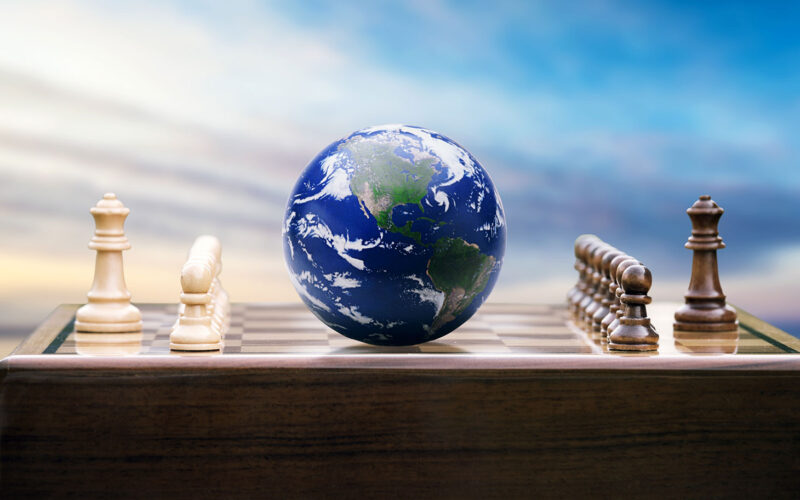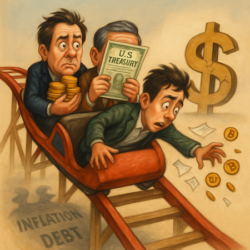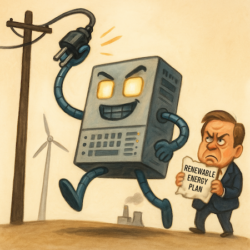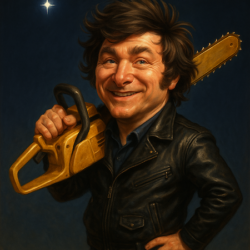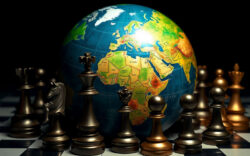Publisher’s Note: If you listen to the mainstream, tariffs are bad. Not just for America, but for the world. But as Bloomberg reports, President Trump’s tariffs brought in an extra US$15 billion tax revenue for March. In dollar terms, it’s the highest amount ever. Estimates are the revenue for April and May will be even higher.
Does that mean Trump’s tariffs are a proven success? It’s too early to say that. But it shows the tariffs have had an impact already. How this plays out over the longer term is still to play out. But arguably there are more important factors to consider. Jim Rickards explains this in more detail below…
With so much attention focused on U.S. stock markets, it’s easy for British investors to overlook the bigger picture. Yet what happens overseas inevitably ripples through our economy too — in ways few fully appreciate.
King Dollar Still Rules
The dollar still dominates the global financial system despite the cracks in the foundation and the valid criticisms. If there’s a dollar problem in Eurodollar banks, it’s sure to echo from Tokyo to Shanghai and New York. And problems in those locales affect everything else.
I’ve just returned from separate visits to India, Japan and Jekyll Island, Georgia. India has the largest population in the world, has the fifth largest economy, is a nuclear power and a key member of BRICS. Japan is the fourth largest economy in the world and is a key geopolitical ally of the United States in its faceoff with China. Jekyll Island is a lovely ocean resort but is best known as the site of a secret meeting in 1910 where the Morgan, Rockefeller and Warburg interests dreamed up the Federal Reserve System.
I continually urge people to get away from their desks, stop staring at screens and go out and talk to real people. There’s no substitute for walking the streets around the world (including the poorest areas) if you really want to know what’s going on.
While India, Japan and Jekyll Island could hardly be more diverse and geographically scattered, they share a common thread. It’s their economic linkage through the U.S. dollar. The following are some impressions I gathered during these visits that reflect the volatile situation facing markets today.
A Reasonable Response to Tariffs
India and Japan had the most reasoned response to Trump’s new tariff policies. Trump quickly backed off his high “reciprocal” tariffs (27% for India and 24% for Japan) and reverted to his blanket 10% tariff on all imports for every country in the world except China.
Responses varied from retaliation tariffs (proposed by Canada, China and the EU) to a much more reasonable approach of simply asking the White House for a meeting to sit down and discuss the issue amicably with a view to lowering tariffs in both directions. Japan and India fell into this latter category and are being rewarded by being included among the first countries that will actually have that opportunity. (Mexico has also taken the moderate route by engaging in discussions rather than retaliation).
There will be some give and take. Some U.S. tariffs on certain items are likely to remain in place. But the optimal solution is not to cut down on U.S. purchases from those countries but for them to buy more from the U.S.
That trims the U.S. trade deficit without reducing world trade and so constitutes a win-win resolution with both India and Japan. India will likely buy more military hardware and semiconductors from the U.S. Japan will likely buy more agricultural goods including soybeans and beef. The result will be higher growth in the U.S.
Bilateral deals like this have losers. Taiwan may miss out on some semiconductor sales (although they are investing hundreds of billions of dollars to build semiconductors in the U.S.). Russia may miss out on military sales to India although they will remain a major energy supplier. Still, the U.S. is done being the “consumer of last resort” to the world and wants to increase its profile as a seller. Trump’s policies move the U.S. in that direction.
Take Care of Your Own
There is little question that the new U.S. tariff policy will hurt some countries around the world. Not to sound harsh, but that’s their problem. Trump’s job is to make America great again. President Xi’s job is to make China great again. Chancellor-in-waiting Merz’s job is to make Germany great again.
The U.S. cannot carry the world on its back. If other countries (rich or poor) took Trump’s growth-oriented approach instead of free riding on America, the entire world would be better off. That’s certainly the view from the White House and is a good guide to U.S. policy going forward.
Defenders of China point to the fact that Chinese exports are not a particularly large percentage of their total GDP. (Germany is the worst offender by that metric). The problem with that data point does not come from the Chinese export number; I’m sure that’s roughly correct. The distortion comes from the GDP denominator. Chinese GDP is overstated by 100% (at least) perhaps more, and China may already be in a recession.
The reason is that China shows about 45% of its GDP as investment, mostly in the form of government backed construction. I’ve been to the ghost cities in China and seen more on the horizon. I got mud on my boots on the construction sites (except I was wearing Italian loafers). There is real steel, glass and copper in the buildings and it takes real labor to build them. That all counts as GDP.
But they’re all empty. If you used GAAP or international accounting principles, you would write that investment down to zero immediately. You can’t put a ghost city into inventory. Buildings age rapidly and take enormous amounts to maintain. I saw this in the Congo in the early 1980s. They had a commodity boom in the 1970s and wasted much of the money on skyscrapers and other showcase projects.
By the time I arrived there, the windows were falling out and rust stains ran down the sides of their showcases. The same thing will happen in China. Once you make that accounting adjustment for wasted investment, GDP shrinks, and the Chinese export/GDP ratio goes up exponentially. China is much more dependent on exports for any real growth than most analysts realize. Trump and Scott Bessent have this right.
It All Depends on Conditions
Tariffs are not automatically good or bad for an economy. Their impact depends on initial conditions when the tariffs are imposed. Tariffs are a tool that should be applied judiciously. A country that overinvests and under consumes will be hurt by tariffs. The tariffs will increase investment and restrain consumption, making the imbalance worse. That’s what happened to the U.S. under the Smoot-Hawley Tariffs in 1930 and later.
A country that over consumes and underinvests will benefit from tariffs. That’s the situation in the U.S. today. The tariffs will increase investment as foreign and domestic investors build new plants behind tariff walls. Tariffs will channel consumer dollars from consumption into savings, which is also desirable. In the end, consumption will expand not because of cheap imports but because of high-paying U.S. jobs.
China is in the category that overinvests (much of it wasted) and under consumes. China’s best strategy would be to lower its own tariffs and allow its people to spend their savings on imported goods from the U.S. and EU along with their own production. That would reduce China’s trade surplus with the U.S., increase China’s GDP and improve the well-being of its own people. It would also make an excellent opening move in any effort to get the U.S. to reduce its tariffs on China.
The U.S. is making good use of tariffs. China is doing the opposite. China may be fighting to a draw in the rhetorical war, but it will definitely lose the trade war. Japan, India and Mexico are models of how to make progress. China is the poster child for how to fail.
Global supply chains will no doubt be disrupted by the tariff and trade wars now erupting. Reconfiguring supply chains will be a one-to-two-year transition. But once it’s done, the new supply chains will prove durable. Volkswagen blundered badly by putting its new Audi Q5 plant in Mexico. Their U.S. sales are booming right now (beat the tariffs!) but will fall off a cliff once dealer inventories are drained and tariffs apply. Still, that’s a management blunder not a global disruption. Supply chains are adaptable with a lag. U.S. soybeans will soon be on their way to Japan if China doesn’t want them.
As an aside, Elon Musk’s shelf life in the White House pantry will soon expire. Musk sparked a pointless feud with White House trade and manufacturing czar Peter Navarro. I know Peter fairly well (a conversation with him is like a graduate level oral exam but that’s another matter). When Elon attacked Navarro, he messed with the wrong guy. Navarro took a bullet for Trump by serving four months in a federal penitentiary rather than answer a subpoena that sought to pierce the veil of executive privilege between the two. That’s the kind of loyalty Trump respects. Navarro also happens to be right about tariffs despite Musk’s whining.
The Silent Financial Crisis
With regard to the Federal Reserve System that emerged from the swamps around Jekyll Island, the Fed has fallen into complete irrelevance. They have modest impact on the short-end of the yield curve (Treasury bills) but have no material impact on the intermediate- and long-end of the yield curve (Treasury notes and bonds).
U.S. national debt and spending will never be brought under control. But sustainable growth can be stimulated by sound fiscal policies, if not by the Fed. As long as nominal growth is greater than nominal debt increases, then the U.S. debt-to-GDP ratio will shrink. That’s the simple formula behind Scott Bessent’s Three Arrows plan and it can feed on itself in a virtuous circle.
What the Fed and the Treasury have done (mostly under Biden) is to create a global dollar shortage, which is now morphing into a global liquidity crisis. China is not dumping Treasuries because they’re distancing themselves from the dollar. Quite the opposite. China is selling Treasuries because they’re desperate for dollars and can’t get them from Japanese banks who have their own problems with carry trade unwinds.
The liquidity crisis then goes back to European banks who can’t fund in Eurodollars and U.S. hedge funds who can’t find collateral to support their derivatives basis trades. India is not immune.
The best description of a financial crisis I’ve ever heard is that “Everybody wants his money back.” We’re dangerously close to that situation right now. If it gets worse, trade, tariffs and stock markets will be a sideshow. Watch Treasury yields and foreign exchange markets if you really want to know what’s going on.
Best,

Jim Rickards
Contributing Editor, Investor’s Daily
P.S. What I described today — from the dollar’s dominance to the silent cracks forming in global finance — is just the tip of the iceberg. President Trump has already triggered a hidden mechanism inside the U.S. system that could reshape the global economy for generations. It’s not just about tariffs or trade. It’s about unleashing an estimated $150 trillion transformation most investors aren’t prepared for. I explain the full story and how you could position yourself in my American Birthright briefing. I urge you to watch it now.
Tools of History
Bill Bonner, writing from the ranch at Gualfin
“King of Kings Ozymandias am I. If any want to know how great I am and where I lie, let him outdo me in my work.”
—Diodorus Siculus
Nations can go on…and on. The Chinese are still Chinese. The Turks are still in Turkey. And the French will always be with us.
But empires rise and fall, with a lifespan of only about 250 years, on average. A visit to the imperial graveyard would show us tombstones of the Assyrians, the Medes, the Ashanti, the Aztec, Austro-Hungarians…and so on…and perhaps even the “two vast and trunkless legs of stone” described by Shelley. They spoke different languages. They had different trade and immigration policies. Some were rich. Others were poor.
What they all have in common is that they are all dead. They sleep among the shades. They are all gone. Finished.
How do empires die? The subject has been studied for many years. By historians. By poets. By religious nuts and scientific nerds. Diodorus was on the case in the 1st century BC. He claimed to have found the inscription above on the tomb of Ramses II in Egypt, later inspiring Shelley’s famous poem.
And while there is no single answer as to what does them in, opinions converge on the two main empire killers…money and military. Too little of the former; too much of the latter. In some cases, natural or demographic disasters play a role. But usually, the death of an empire has man-made causes.
‘Man-made’ disasters need leaders. Alexander led his troops to the Ganges and to the Nile…thus installing a Macedonian dynasty in Egypt that Diodorus, a Greek from Sicily, was able to visit. He got there just in time. The last of the Ptolemaic rulers was Cleopatra, who made the mistake of taking Marc Antony for a lover and ally. Ms. Cleopatra might be described as a ‘tool of history,’ helping to put an end to the group that had ruled Egypt for 275 years. Then, when Octavian defeated Antony at the battle of Actium, it was all over, not just for her and Antony, but for the Greeks in Egypt. Another empire — Roman — took over in 30 BC.
Which brings us, like fleas to a dog, to our own Donald J. Trump. He is the Big Man…the Caesar of today. L’etat..c’est lui!
We know what he says he is trying to do. His supporters (some of them) think he was spared by God to do it. But God thinks big. Long term. In historical terms, not limited to the election cycle. And at this stage of America’s empire journey — after nearly 250 years of sweeping all before it — we have to wonder…what is Donald J. Trump really meant to do? Take it to even greater glory? Or, to fulfill the natural life-cycle of all empires…that is, to help it into the past, not the future?
If America were to develop into an even bigger, stronger empire it would first have to avoid going broke. That is a relatively obvious threat…and one that is relatively easy to avoid. From the chief executive’s point of view, he would simply insist that henceforth outflows match inflows — something a hundred million American households are able to do every year. He might even quote our old friend Sid Taylor in warning: ‘When your outflow exceeds your income, your upkeep is your downfall.’
Trump’s Treasury Secretary, Scott Bessent, said the administration’s goal was to shift resources away from the government so as to give the private sector a chance to grow. Were he really trying to take the empire to greater heights, Donald Trump would make that his Number One priority and veto any spending that added to US debt. Then, the strength of the economy might power the empire to further success.
Of course, it would be up to Congress to decide where to cut. This, too, would be easy, in theory…though politically difficult. Small cuts to domestic spending programs, including means-testing social welfare/pension/medical care benefits, would be enough to bring homeland spending into line.
Easier still, the military/overseas spending could be cut in half — a savings of some $500 billion — simply by focusing on an America First homeland defense. But in the press Friday was this remarkable headline, the Daily Express:
Trump drops ‘Crimea will stay with Russia’ bombshell and urges Ukraine to give in
What is amazing about this is not that Crimea should stay with Russia. It was originally annexed from the Turks by Catherine the Great in 1783…about the same time as the Americans ‘annexed’ the colonies from the British empire.
What is shocking is that an American president should think it is his place to decide the issue. Who elected him president of the Crimeans? Does he speak any of the major languages of the peninsula? Could he find it on a map? Why then does he think it’s up to him to choose the government?
This is the kind of ‘imperial overstretch’ that the gods punish. Along with big increases to the military budget…trade wars…chaos, incompetence…and deficits headed towards $2 trillion annually — it begins to look as though the real purpose of Team Trump were to destroy the empire, not to make it great again.
Could it be that Mr. Trump has unwittingly become a tool of history too?
More to come…
Regards,

Bill Bonner
Contributing Editor, Investor’s Daily
For more from Bill Bonner, visit www.bonnerprivateresearch.com
